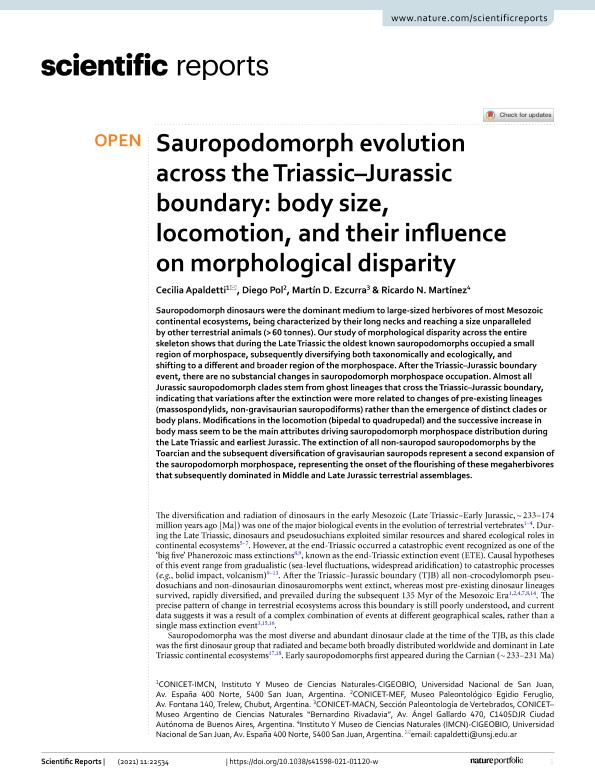Mostrar el registro sencillo del ítem
dc.contributor.author
Apaldetti, Graciela Cecilia

dc.contributor.author
Pol, Diego

dc.contributor.author
Ezcurra, Martin Daniel

dc.contributor.author
Martínez, Ricardo Néstor

dc.date.available
2022-08-24T18:04:12Z
dc.date.issued
2021-12
dc.identifier.citation
Apaldetti, Graciela Cecilia; Pol, Diego; Ezcurra, Martin Daniel; Martínez, Ricardo Néstor; Sauropodomorph evolution across the Triassic–Jurassic boundary: Body size, locomotion, and their influence on morphological disparity; Nature Publishing Group; Scientific Reports; 11; 22534; 12-2021; 1-11
dc.identifier.issn
2045-2322
dc.identifier.uri
http://hdl.handle.net/11336/166476
dc.description.abstract
Sauropodomorph dinosaurs were the dominant medium to large-sized herbivores of most Mesozoic continental ecosystems, being characterized by their long necks and reaching a size unparalleled by other terrestrial animals (> 60 tonnes). Our study of morphological disparity across the entire skeleton shows that during the Late Triassic the oldest known sauropodomorphs occupied a small region of morphospace, subsequently diversifying both taxonomically and ecologically, and shifting to a different and broader region of the morphospace. After the Triassic–Jurassic boundary event, there are no substancial changes in sauropodomorph morphospace occupation. Almost all Jurassic sauropodomorph clades stem from ghost lineages that cross the Triassic–Jurassic boundary, indicating that variations after the extinction were more related to changes of pre-existing lineages (massospondylids, non-gravisaurian sauropodiforms) rather than the emergence of distinct clades or body plans. Modifications in the locomotion (bipedal to quadrupedal) and the successive increase in body mass seem to be the main attributes driving sauropodomorph morphospace distribution during the Late Triassic and earliest Jurassic. The extinction of all non-sauropod sauropodomorphs by the Toarcian and the subsequent diversification of gravisaurian sauropods represent a second expansion of the sauropodomorph morphospace, representing the onset of the flourishing of these megaherbivores that subsequently dominated in Middle and Late Jurassic terrestrial assemblages.
dc.format
application/pdf
dc.language.iso
eng
dc.publisher
Nature Publishing Group

dc.rights
info:eu-repo/semantics/openAccess
dc.rights.uri
https://creativecommons.org/licenses/by/2.5/ar/
dc.subject
Jurásico
dc.subject
Triásico
dc.subject
Sauropodomorpha
dc.subject
Disparidad
dc.subject.classification
Paleontología

dc.subject.classification
Ciencias de la Tierra y relacionadas con el Medio Ambiente

dc.subject.classification
CIENCIAS NATURALES Y EXACTAS

dc.title
Sauropodomorph evolution across the Triassic–Jurassic boundary: Body size, locomotion, and their influence on morphological disparity
dc.type
info:eu-repo/semantics/article
dc.type
info:ar-repo/semantics/artículo
dc.type
info:eu-repo/semantics/publishedVersion
dc.date.updated
2022-08-23T11:17:19Z
dc.journal.volume
11
dc.journal.number
22534
dc.journal.pagination
1-11
dc.journal.pais
Reino Unido

dc.journal.ciudad
Londres
dc.description.fil
Fil: Apaldetti, Graciela Cecilia. Consejo Nacional de Investigaciones Científicas y Técnicas. Centro Científico Tecnológico Conicet - San Juan. Centro de Investigaciones de la Geosfera y Biosfera. Universidad Nacional de San Juan. Facultad de Ciencias Exactas Físicas y Naturales. Centro de Investigaciones de la Geosfera y Biosfera; Argentina
dc.description.fil
Fil: Pol, Diego. Consejo Nacional de Investigaciones Científicas y Técnicas; Argentina. Museo Paleontológico Egidio Feruglio; Argentina
dc.description.fil
Fil: Ezcurra, Martin Daniel. Consejo Nacional de Investigaciones Científicas y Técnicas. Oficina de Coordinación Administrativa Parque Centenario. Museo Argentino de Ciencias Naturales "Bernardino Rivadavia"; Argentina
dc.description.fil
Fil: Martínez, Ricardo Néstor. Universidad Nacional de San Juan. Facultad de Ciencias Exactas, Físicas y Naturales. Instituto y Museo de Ciencias Naturales; Argentina
dc.journal.title
Scientific Reports
dc.relation.alternativeid
info:eu-repo/semantics/altIdentifier/doi/http://dx.doi.org/10.1038/s41598-021-01120-w
dc.relation.alternativeid
info:eu-repo/semantics/altIdentifier/url/https://www.nature.com/articles/s41598-021-01120-w
Archivos asociados
